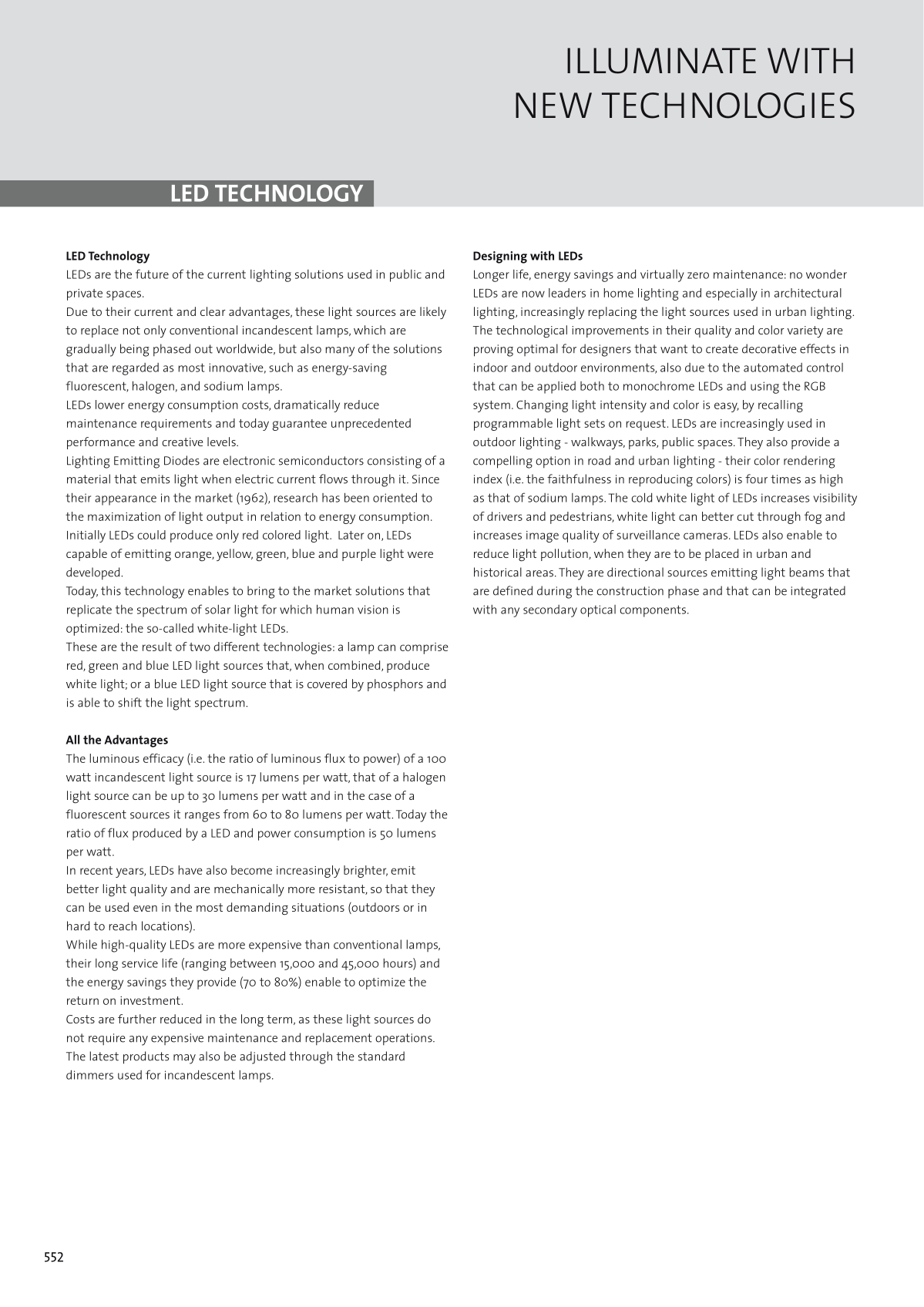552
ILLUMINATE WITH
NEW TECHNOLOGIES
LED TECHNOLOGY
LED Technology
LEDs are the future of the current lighting solutions used in public and
private spaces.
Due to their current and clear advantages, these light sources are likely
to replace not only conventional incandescent lamps, which are
gradually being phased out worldwide, but also many of the solutions
that are regarded as most innovative, such as energy-saving
fluorescent, halogen, and sodium lamps.
LEDs lower energy consumption costs, dramatically reduce
maintenance requirements and today guarantee unprecedented
performance and creative levels.
Lighting Emitting Diodes are electronic semiconductors consisting of a
material that emits light when electric current flows through it. Since
their appearance in the market (1962), research has been oriented to
the maximization of light output in relation to energy consumption.
Initially LEDs could produce only red colored light. Later on, LEDs
capable of emitting orange, yellow, green, blue and purple light were
developed.
Today, this technology enables to bring to the market solutions that
replicate the spectrum of solar light for which human vision is
optimized: the so-called white-light LEDs.
These are the result of two different technologies: a lamp can comprise
red, green and blue LED light sources that, when combined, produce
white light; or a blue LED light source that is covered by phosphors and
is able to shift the light spectrum.
All the Advantages
The luminous efficacy (i.e. the ratio of luminous flux to power) of a 100
watt incandescent light source is 17 lumens per watt, that of a halogen
light source can be up to 30 lumens per watt and in the case of a
fluorescent sources it ranges from 60 to 80 lumens per watt. Today the
ratio of flux produced by a LED and power consumption is 50 lumens
per watt.
In recent years, LEDs have also become increasingly brighter, emit
better light quality and are mechanically more resistant, so that they
can be used even in the most demanding situations (outdoors or in
hard to reach locations).
While high-quality LEDs are more expensive than conventional lamps,
their long service life (ranging between 15,000 and 45,000 hours) and
the energy savings they provide (70 to 80%) enable to optimize the
return on investment.
Costs are further reduced in the long term, as these light sources do
not require any expensive maintenance and replacement operations.
The latest products may also be adjusted through the standard
dimmers used for incandescent lamps.
Designing with LEDs
Longer life, energy savings and virtually zero maintenance: no wonder
LEDs are now leaders in home lighting and especially in architectural
lighting, increasingly replacing the light sources used in urban lighting.
The technological improvements in their quality and color variety are
proving optimal for designers that want to create decorative effects in
indoor and outdoor environments, also due to the automated control
that can be applied both to monochrome LEDs and using the RGB
system. Changing light intensity and color is easy, by recalling
programmable light sets on request. LEDs are increasingly used in
outdoor lighting - walkways, parks, public spaces. They also provide a
compelling option in road and urban lighting - their color rendering
index (i.e. the faithfulness in reproducing colors) is four times as high
as that of sodium lamps. The cold white light of LEDs increases visibility
of drivers and pedestrians, white light can better cut through fog and
increases image quality of surveillance cameras. LEDs also enable to
reduce light pollution, when they are to be placed in urban and
historical areas. They are directional sources emitting light beams that
are defined during the construction phase and that can be integrated
with any secondary optical components.


